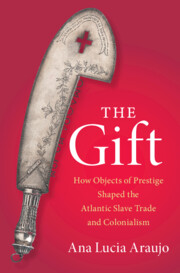Book contents
- The Gift
- Cambridge Studies on the African Diaspora
- The Gift
- Copyright page
- Contents
- Maps and Figures
- Maps
- Acknowledgments
- Introduction
- 1 The Loango Coast and the Rise of the Atlantic Slave Trade
- 2 La Rochelle and Atlantic Africa
- 3 Slave Traders Turned Pirates
- 4 Deciphering the Gift
- 5 A Displaced Gift
- 6 Ngoyo Meets Dahomey
- Conclusion
- Notes
- Bibliography
- Index
3 - Slave Traders Turned Pirates
Published online by Cambridge University Press: 26 October 2023
- The Gift
- Cambridge Studies on the African Diaspora
- The Gift
- Copyright page
- Contents
- Maps and Figures
- Maps
- Acknowledgments
- Introduction
- 1 The Loango Coast and the Rise of the Atlantic Slave Trade
- 2 La Rochelle and Atlantic Africa
- 3 Slave Traders Turned Pirates
- 4 Deciphering the Gift
- 5 A Displaced Gift
- 6 Ngoyo Meets Dahomey
- Conclusion
- Notes
- Bibliography
- Index
Summary
This chapter examines the conflictual context of the slave trade on the Loango coast. European slave merchants competed with each other, and French slave merchants from various ports clashed as well. French slave traders provided local agents with goods that had local demand and also attempted to respond to the specific tastes of local rulers and agents, to whom they paid customs, often referred to as presents. When these arrangements failed, ship captains did not hesitate to give themselves the upper hand by sabotaging their European rivals. The chapter shows how, on occasion, French traders also physically assaulted even their compatriots by stealing their cargos of commodities and human beings. Despite European pressures to monopolize the trade in the region, the rulers of Ngoyo, Kakongo, and Loango kept significant control over their territories during the eighteenth century. However, on some occasions, Ngoyo’s Woyo residents of Cabinda supported the French to fight the Portuguese who also attempted to control the region. Likewise, in some situations, local traders sided with specific French traders in detriment of others as well. Understanding these conflicts is central to grasp the importance of gifts of prestige and local agents in the trade of enslaved Africans on the Loango coast.
- Type
- Chapter
- Information
- The GiftHow Objects of Prestige Shaped the Atlantic Slave Trade and Colonialism, pp. 52 - 74Publisher: Cambridge University PressPrint publication year: 2023



